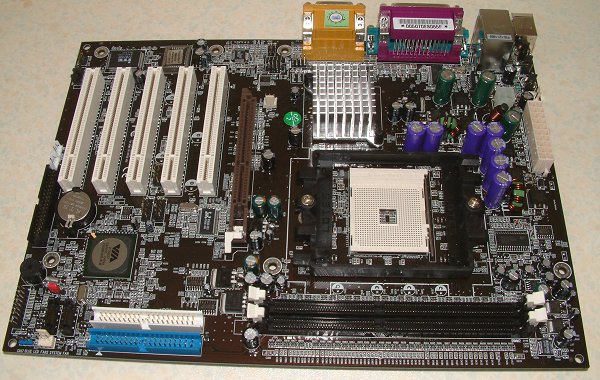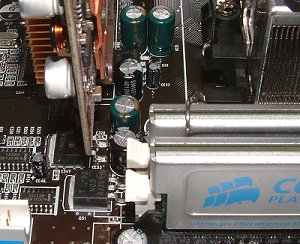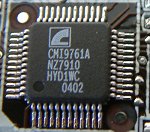Layout and features

Initial impressions that this is a narrow motherboard are confirmed via Chaintech's specifications. A width of 22cm is a definite PCB-saving measure. It's clear from the outset that Chaintech intends to position the SK8T800 as a budget S754 board. Nothing wrong with that if done correctly. The most interesting part of layout has to be the locations of the 2 power plugs. They're on the right-hand extremity.

It's actually a very good idea. The socket has been moved centrally so wires don't interfere with the CPU fan's airflow. Having seen this kind of arrangement it's hard to work out why others haven't tried the same thing. It looks as if Chaintech was forced into it from a lack of PCB space. A 2-phase power supply is of some concern, especially with the luxurious ZNF3-250 a recipient of a 4-phase design. Again, this is a cost-cutting measure that fits in well with the board's market positioning. 2 bridges means one thing. that this is a VIA K8T800-powered motherboard. As such, there's only 2 DIMM slots that are both capable of handling DDR400 memory. nForce3 variants often ship with three, but the third is rarely ratified to run at DDR400 speeds. So no great loss here.

A Chaintech trait seems to be in leaving sufficient space between DIMM slots and AGP slot. It's something, as a tester, that I can really appreciate. Indeed, given the lack of apparent space, the SK8T800 allows for a very clean setup. Top marks for right-hand component placement. Perhaps another fan header near the CPU would have been handy, though.

VIA's VT8237 southbridge provides native SATA support, both in independent and RAID formats. That's good news for Chaintech, for there's no need to supply expensive discrete controllers and ports. The narrowness has pushed primary and secondary IDE ports down to the bottom section. This is only a worry if you have extra-long PCI cards.
One suggestion we'd like to make to Chaintech is to follow EPoX and MSI's lead and use colour-coded motherboard-to-case pins. A dark PCB colour makes pin location a tedious task inside a cramped case. There's no FireWire support here, but we can excuse that on grounds on cost.

It's AC'97 time, folks. We're looking at Rev. 2.3 here. That means auto jack-sensing ability (lets you know if you've placed a plug in the wrong jack, works off impedance levels). 6-channel sound, S/PDIF output, and a Signal-to-Noise ratio of 95 dB makes it a sensible, decent choice for a budget board. Audio sounded clean enough when tested with a pair of Sony CD-1700 studio-class headphones. VIA's VT6103 transceiver (PHY) chip uses the southbridge's 10/100 MAC for networking duties. Chaintech's made good use of VIA's initial S754 chipset.

Too much legacy support for out liking. Parallel, COM, and Serial ports oust spots for extra USB2.0 and S/PIF-out. The three audio jacks double-up for 6-channel sound. No great surprises here. The board is compact and component location is, subjectively speaking, excellent. Supermarkets have their own line of 'no-frills' food, here is Chaintech's no-frills motherboard. It, however, needs to be accompanied by a low price.









